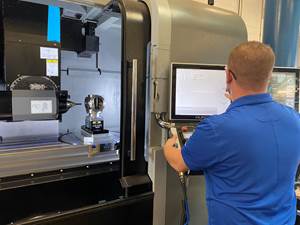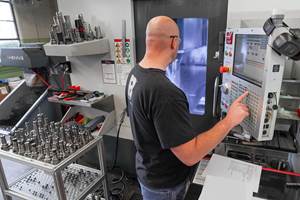Technology for Turning on a Five-Axis Machine
A turning tool adapter that mounts to the MCT five-axis machine isolates the main spindle bearing from the shock of turning operations.
Share





Five-axis machine tools combine linear XYZ travels with A- and B-axis rotation to enable the machining of five sides of a part in one setup. Some are used to perform 3+2 operations, whereby the part is rotated and locked into an angled position, and the machine essentially performs a three-axis operation with the part oriented in that way. Others can execute more complex, full-contouring five-axis operations that use simultaneous linear and rotational motions to pass a cutting tool over a contoured surface.
In some cases, attachments can be used to enable these machines to perform turning operations, too. However, when static turning tools are mounted directly into a machine’s main spindle, as they typically are, the shock loads common to turning can eventually lead to spindle bearing damage.
This has spurred Burkhardt + Weber, part of Industrias Romi SA, to develop its MCT line of five-axis machines. The MCT series includes five machine models that can turn parts ranging in diameter from 11.8 to 110 inches and weighing as much as 8,818 pounds at a maximum rotational speed of 600 rpm (workpiece capacity when turning is not performed is 15,432 pounds). These machines feature the following integral design elements said to enable productive turning, even for non-symmetrical parts, without causing damage to the spindle bearing system:
Turning tool adapter. With the conventional approach of inserting a static turning tool into a five-axis machine’s spindle, the spindle rotor is often clamped to the spindle’s outer housing in order to lock it in a stationary position to protect against possible turning shock loads. Lighter cuts are also typically performed to prevent bearing damage, but this leads to lower productivity.
Conversely, the MCT machines feature an automatically exchanged tooling adapter that mounts to the spindle housing via a zero-point clamping mechanism, isolating the spindle bearings from the shock of turning operations. The system uses four clamping cylinders located 9.84 inches apart and supplies 26,400 pounds of clamping force to secure the turning tool adapter to the spindle housing. Turning tools can be automatically loaded and unloaded into the adapter just like a milling tool from the machine’s ATC.
Table balance control. Because parts to be turned on a five-axis machine often aren’t symmetric, the MCT machines feature a compensating balance-control system. After a part or pallet is loaded and securely clamped to the machine’s table via a mechanical spring-based safety system, a balancing cycle is automatically performed at 80 rpm using sensors to measure rotational forces. Afterwards, a display on the machine’s CNC shows the location and amount of counterweight required to bring the system into balance. Turning operations can proceed once balance quality is confirmed after another 80-rpm test cycle.
Thermal isolation system. Torque motors in rotary tables used for turning on a five-axis machine generate a good deal of heat, causing unpredictable expansion and contraction of a machine’s frame that can adversely affect accuracy and repeatability. Rather than using complex temperature-compensating software algorithms and sensor feedback, the MCT machines remove heat surrounding the table and frame with an actively controlled cooling system, stabilizing the frame by maintaining a consistent temperature. In addition, the company developed a non-contact, 16-channel hydraulic rotary sealing system for the machine line’s 600-rpm tables that does not generate heat due to friction or wear of mating seal surfaces common to
conventional systems.
Related Content
Does a Five-Axis Machine Increase Business?
Five-axis machining is enabling custom fabricator Meyer Tool to take on more complex work and helping it produce less complex jobs more efficiently.
Read MoreInverting Turning and Five-Axis Milling at Famar
Automation is only the tip of the iceberg for Famar, which also provides multitasking options for its vertical lathes and horizontal five-axis machine tools.
Read MoreMedical Shop Performs Lights-Out Production in Five-Axes
Moving to five-axis machining enabled this shop to dramatically reduce setup time and increase lights-out capacity, but success relied on the right combination of workholding and automation.
Read MoreInside a CNC-Machined Gothic Monastery in Wyoming
An inside look into the Carmelite Monks of Wyoming, who are combining centuries-old Gothic architectural principles with modern CNC machining to build a monastery in the mountains of Wyoming.
Read MoreRead Next
AMRs Are Moving Into Manufacturing: 4 Considerations for Implementation
AMRs can provide a flexible, easy-to-use automation platform so long as manufacturers choose a suitable task and prepare their facilities.
Read MoreMachine Shop MBA
Making Chips and 91ÊÓƵÍøÕ¾ÎÛ are teaming up for a new podcast series called Machine Shop MBA—designed to help manufacturers measure their success against the industry’s best. Through the lens of the Top Shops benchmarking program, the series explores the KPIs that set high-performing shops apart, from machine utilization and first-pass yield to employee engagement and revenue per employee.
Read More





















